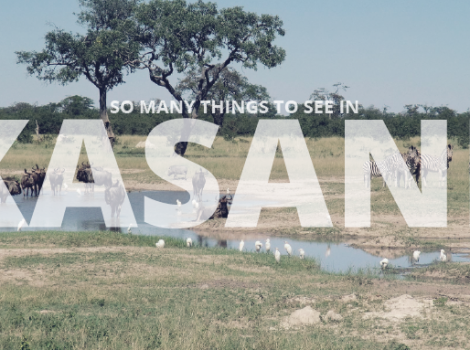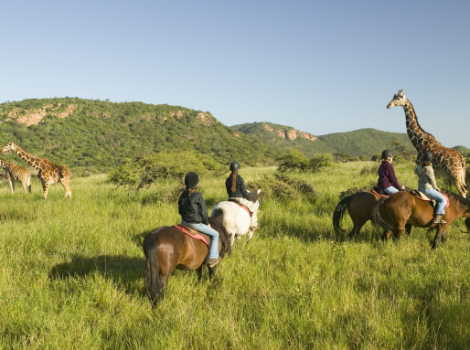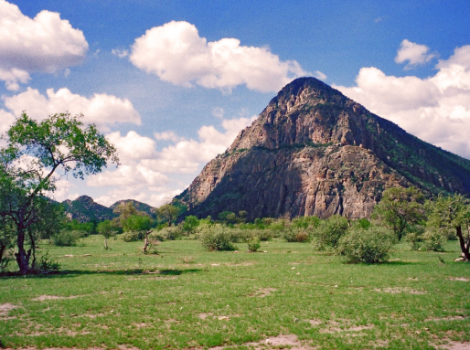1. Birds and Game Botswana
Botswana is an animal orphanage established by Uncharted Africa. Birds and Game Botswana has been rescuing and nurturing injured and orphaned wild animals and birds for the past twenty years. They aim to restore the animals to full health and then release them back into their natural habitat. The owners have over the years cared for elephants, cheetah, leopard, crocodiles, snakes and various birds, among others.
Birds and Game Botswana is very popular among the locals, schools and visitors. It also serves as an educational centre where people can learn about conservation, ecology and geology.
It’s open every day at the following times: 10.00 – 13.00 and 14.00 – 16.00
*A small fee applies.
2. Supa Ngwao Museum
Supa Ngwao (meaning show culture) lies on the New Maun Road and is home to exhibitions that showcase the Kalanga people’s culture and history, as well as historical photos of early Francistown and Botswana.
Also on show are collections of pottery, woodcarvings, basketry and musical instruments. There’s a curios shop that sells authentic, hand-made crafts that would make fantastic gifts and souvenirs. The curios shop employs about 200 craftsmen and women, most of whom are from Francistown and surrounding areas.
Additionally, the Museum serves as an information centre for Francistown and offers guided walking tours of the city, covering most of the important historical sites.
Update – 04/02/2017: Supa Ngwao has confirmed to YourBotswana that the museum is temporarily closed to the public. They have however, assured us that it will open shortly, but couldn’t give us specific dates. Please watch this space; as soon as we hear back from Supa Ngwao, we’ll let you all know. Thanks to Sara Glendinning for bringing this to our attention.
3. Tachila Nature Reserve
The reserve covers approximately 8 200 hectares of well-preserved natural habitat in an area adjacent to Francistown city. It’s easily accessible by car and visitors are able to go on self-drive game drives. Prior arrangements have to be made before turning up. Tachila is a Kalanga word meaning ‘saviour of all living things’. It’s a community project that offers natural, archaeological, historical and cultural attractions unique to Francistown and the North East District.
Tachila’s mandate:
To serve as a recreational facility for residents of and visitors to Francistown
To provide environmental education for Botswana school children
To promote wildlife and other natural resources conservation
To increase eco-tourism potential
To help diversify the largely mining – dependent economy, by creating employment opportunities.
Wildlife including leopard, hyena, kudu, impala, bushbuck, steenbok, klipspringer, and warthog can be spotted in the reserve. There are plans to ultimately introduce rhino, sable and roan antelope, cheetah, giraffe, zebra, wildebeest and eland to the reserve.
There are also plans to build a luxury lodge and campsite, conference centre and restaurant on the reserve. The idea is to make all structures eco-friendly, run on renewable energy, run recycling programs including grey-water reticulation and grow organic gardens.
In terms of excursions, Tachila also aims to offer nature and historical walks, game drives, informative talks and workshops. Planned braai and picnic sites that will ultimately promote tourism and help diversify the local economy are other facilities that friends of Tachila can look forward to.
Tachila intends to help promote long-term conservation of biodiversity and the sustainable use of natural resources, by working closely with the Mokolodi Nature Reserve (Gaborone). They intend to do so by raising environmental awareness through a proposed environmental education centre.
The Mokolodi education program is a resounding success, with over 12000 children visiting Mokolodi each year. This is the level of success that Tachila hopes to achieve in Francistown. Tachila Nature Reserve Trust, a registered charity, runs Tachila Nature Reserve. A team of volunteers from Francistown’s business community governs the trust.
4. Domboshaba Hill and Ruins
Domboshaba Hill (loosely translated means “red” or “Eland hill”) is located in the North Eastern District in Kalakamati village, along the Francistown-Nata Road. Domboshaba principally consists of dry stonewalls. It was occupied towards the end of the Great Zimbabwe period (1250-1450AD) of the Iron Age.
Situated in North East Botswana along the Masunga- Kalamati Road, the site at which Domboshaba ruins are located has hills and the ruins, which are major historic sites that have become a tourist attraction. The ruins are a display of unique stonework; the unique ‘architectural’ signature of the Banyayi- Bakalanga Empire and civilisation which stretches as far back as Khami Ruins near Bulawayo in Zimbabwe. They are the remains of a settlement believed to be a tributary of Great Zimbabwe. The ruins are clearly signposted from the road. The stone wall site is believed to date as far back as1450AD.
Domboshaba ruins is approximately 8 hectares in area and the site includes several enclosures and the remains of partitions and bulkheads, the most spectacular of which is ‘Wall 28.’ Wall 28′ is a structure which was rebuilt by archaeologists and incorporates beautifully flowing courses of granite blocks built around existing boulders and trees. Domboshaba contains excellent examples of cement-less, stonewalls and enclosures, some of which were reconstructed by the National Museum archaeologists. It was one of the first National Monuments to be gazetted in the country, in 1938.
The most striking features of the walls are their evenness, despite their massive width (some measure 2 metres thick) and their beautiful decorative motifs and stylistic variations, both underlining the absolute precision and aesthetic considerations with which they were built. Despite the fact that no cement was used in their construction, some walls have survived intact for centuries.
Further up the hill, the floor plan of what is believed to have been a headman’s or chief’s residence can be seen. And the circular remains of houses that once dotted this community reveal earthen floors with stone edgings. Many walls have collapsed and the National Museum has prioritised this site for further restoration and development, including improved trail signage, camping and ablution facilities. Access to this national cultural heritage is very easy and doesn’t necessarily require a four-wheel drive.
The artefacts and crafts found at the ruins have led to the conclusion that the Domboshaba hills were an area of trade. They include gold, copper, ivory, porcelain from China and India, pottery and both human and animal bones.
The discovery of artefacts and crafts at the site shows Domboshaba was part of the Eastern coast trade network going as far as Mozambique. Most of the artefacts have been taken to the national museum in Gaborone for preservation purposes.
Additionally, keen bird watchers will be thrilled to know that Domboshaba Ruins is home to many birds, including Swainson’s Francolin (lesogo), guinea fowl (kgaka), laughing dove (lephoi), yellow-billed hornbill (korwe), quelea (thaga), and the go-away bird (mokowe). Three panels of rock paintings are located behind Kalakamati village Kgotla. The paintings depict a variety of scenes ranging from dance, hunting, fingerprints and various animals, which were left behind by the ancestors of Basarwa.
Botswana has over 2,500 National monument sites, of which more than 100 have been gazetted. The National Monuments and Relics Act of 2001 ensures that the sites are adequately protected; most of which are free to visit, while some have full-time guides.
5. Domboshaba Cultural Festival
This annual cultural event is held near Domboshaba Ruins. Botswana Tourism sponsors the publicity and promotion of this event, as it has a strategic input in the diversification efforts through events and destination awareness of the Botswana tourism offering.
This event is hosted in partnership with the local trust, Domboshaba Cultural Trust (DCT). The event has not only grown in terms of attracting audiences from Botswana and Zimbabwe but also because the various activities give attendees a glimpse into the Ikalanga culture.
The event also features a 21.2km Nswazwi half marathon that starts in Sebina and finishes in Makuta. The festival has been celebrated annually since 2000, with the objective of preserving the Ikalanga language and culture. It has grown to become one of the largest cultural festivals in Botswana.
Over the years some critics viewed Domboshaba as an event that could fuel tribalism, as it exclusively celebrated the Ikalanga culture. However, last year the event attracted traditional groups from different parts of Botswana including Molepolole and New Xade in Kgalagadi.
Domboshaba Cultural Trust Coordinator, Chigedze Chinyepi said to show that they are against tribalism; they reached out to other tribes’ traditional groups along to the event. She said this is also because the event now attracts revellers across the tribal divide.
She said whilst the festival promotes the history and culture of Bakalanga, the idea was never to fan tribalism, but rather for other tribes to attend the event to learn more about the Bakalanga and their culture. Chinyepi said equally, the festival serves as a cultural exchange event where Bakalanga are also given the opportunity to learn about different Batswana tribes and their traditions.
6. Kuminda Farm
Kuminda Farm is situated in Marobela lands in the Central District, 2.3 km off the Francistown / Nata road, 45 km from Francistown, opposite the Marobela turn. It is an excellent stopover between Francistown and Nata for those travelling North to either Kasane or Maun.
Kuminda Farm occupies an area of 15 hectares and is a substantially undisturbed natural area of bush, occupied mainly by rock rabbits which live in two rocky outcrops which in turn host some of the largest trees in the area.
A school and college groups stand on the farm, focusing mainly on cultural education/exchange programs as well as cultural events and small scale integrated farming. There is abundant birdlife, plenty of unusual flora and fauna and a tranquil atmosphere.
The traditional structures were built with natural resources and traditional materials in the area, employing traditional techniques.
Lucy Hinchliffe, who was born and bred in Marobela village, owns the farm. Over the years, she has cultivated a high level of interest in community capacity enhancement processes, particularly those that involve women and the youth.
The farm is beautifully appointed with traditional mud buildings and has a small horticultural project that produces fresh vegetables. These vegetables in turn, become part of the menu of traditional meals that the farm serves.
Services
- Cultural events – traditional dance, poetry, song and games.
- Kuminda also hosts the annual Zhizha Ikalanga food and music festival.
- It also offers nature walks, bird viewing (birds spotted there include Meyers parrots, woodpeckers and giant eagle owls), indigenous trees and flowers.
- Kuminda farm serves traditional food only.
- Bookings have to be made at least 14 days in advance
- Accommodation is available in the form of camping site, hired tents and chalets
Find out more: kumindafarm.com
7. Francistown city is strategically located to give you easy access to various destinations of interest!
Ok, this isn’t something you can do in Francistown, but rather from Francistown. YourBotswana felt 7 things to do in Francistown was a better number. But on a serious note, Francistown being where it is, puts the keen traveller at a great advantage of easily and quickly jetting off to the following various places.
The main road North West of Francistown leads to Maun and the Okavango Delta, Kasane and Chobe National Park, Livingstone (Zambia) and Victoria Falls (Zimbabwe). The A1 connects Francistown to Gaborone in the South and to Zimbabwe in the North. The A3 Connects Francistown to Nata and Maun to the West.
There are regular buses from Francistown to Gaborone, as well as direct buses to tourist destinations like Maun and Kasane. People heading towards Bulawayo and Harare in Zimbabwe can catch daily buses from Francistown bus rank.
Are you familiar with or live in Francistown? Are there any other places of interest within Francistown that you’d like to share with YourBotswana? Please feel free to comment.
Reference: botswanatourism.com




Wow, it was a great opportunity checking in. THANK YOU, YOUR BOTSWANA.
This is good news if these places are currently open for visitors – did you go yourself? The museum was closed when I was there last year…